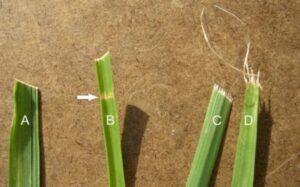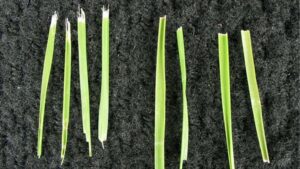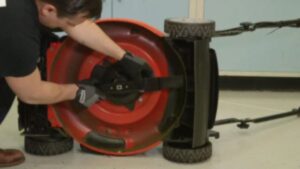Table of Contents

Keeping your lawn looking pristine requires well-maintained mower blades. While new mower blades typically come sharp from the manufacturer, the question remains: do you need to sharpen them further?
Mower blade sharpness is crucial in achieving a clean and even cut, ensuring a healthy and attractive lawn. Dull blades can tear the grass instead of cleanly cutting it, leading to ragged edges and potential damage to the turf.
In this article, we will explore the importance of sharpening mower blades, discuss the condition of new blades, and highlight signs that indicate blade dullness. We will also delve into the benefits of sharpening new blades and provide maintenance tips to help you keep your mower blades sharp for longer.
Why Sharpening Mower Blades is Essential?

Sharpening mower blades is essential for several reasons. Here are some key points to explain why:
Clean and even cut: Sharp mower blades are crucial for achieving a clean and even cut on your lawn. When sharp blades are sliced through the grass cleanly, resulting in a neater and more professional-looking finish; on the other hand, dull blades tend to tear the grass instead of cutting it cleanly, leaving behind uneven and ragged edges.
Healthier lawn: Dull blades can cause damage to the grass. When grass blades are torn instead of cut cleanly, it creates open wounds more susceptible to diseases and pests. Additionally, torn grass takes longer to recover, leading to a weakened and less healthy lawn. Sharpened blades promote healthier growth by minimizing damage and promoting quicker healing.
Improved cutting efficiency: Sharp blades significantly improve the cutting efficiency of your mower. With sharp blades, your mower can easily glide through the grass, reducing resistance and strain on the machine’s engine. This efficiency translates into a smoother mowing experience, less wear and tear on the mower, and potentially lower fuel consumption.
Time and energy savings: Dull blades require more passes over the same area to achieve the desired cut, increasing the time and effort needed for mowing. On the other hand, sharp blades allow you to complete the task more quickly and efficiently. By maintaining sharp blades, you can save valuable time and energy during your lawn care routine.
Aesthetically pleasing results: Whether you take pride in a well-manicured lawn or want to enhance the curb appeal of your property, sharp mower blades are essential. They contribute to a cleaner, more professional-looking lawn with neatly trimmed edges. Aesthetically pleasing results can significantly affect your property’s overall appearance and value.
Signs When Mower Needs to Sharpen

Mower blades are made of high-strength steel to withstand the high-impact shocks of mowing. However, they can’t cut grass as efficiently when they become dull and may cause other problems.
It would be best to sharpen your mower blades when they need it. The following are some signs that indicate you need to sharpen your mower blades:
- The lawn looks ragged, even after you’ve mowed it several times.
- The grass is getting longer between mowings.
- Your lawn is uneven and bumpy, with patches of uncut grass in some areas.
What Causes Dull Mower Blades?

Dull mower blades can be a common problem for many lawn owners, and they can affect the appearance and health of the lawn. Several factors can cause mower blades to become dull over time. Let’s explore some of the main causes:
- Normal Wear and Tear: Mower blades naturally experience wear and tear with regular use. Cutting grass repeatedly causes the blade edges to become blunt and is less effective in cutting the grass blades cleanly.
- Hitting Hard Objects: Accidentally hitting hard objects like rocks, tree stumps, or even large branches can cause the mower blades to chip or become dull. These objects can damage the cutting edges, making a less precise and efficient cut.
- Mowing Over Debris: Mowing over debris such as sticks, twigs, or small rocks can contribute to blade dullness. The impact of these objects can cause nicks and dents in the blades, affecting their cutting ability.
- Improper Blade Maintenance: Neglecting regular blade maintenance can lead to dullness. Blades should be cleaned, sharpened, and balanced periodically to ensure optimal cutting performance. Failure to do so can result in dull blades that tear the grass instead of cutting it cleanly.
- Cutting Wet Grass: Mowing wet grass can increase the chances of blade dullness. Wet grass tends to stick to the blades, forming clumps that hinder the cutting action. This can cause the blades to work harder and become dull more quickly.
- Soil and Sand Particles: Mowing over sandy or abrasive soil can cause tiny soil and sand particles to contact the blade edges. This can lead to abrasion and dullness over time.
Effects of Dull Mower Blades
- Poor Cutting Quality: Dull blades result in ragged, uneven cuts, which can give the lawn an unsightly appearance. It may also increase the risk of lawn diseases and pests, as ragged grass blades are more susceptible to damage.
- Stress on the Lawn: Dull blades tear the grass instead of cleanly cutting it. This causes stress to the grass, making it more vulnerable to diseases, pests, and environmental stressors.
- Reduced Mower Efficiency: Dull blades require more power and effort from the mower to cut the grass, reducing overall efficiency. This can increase fuel consumption and wear on the mower’s engine.
Cautions About Sharpening Dull Blades
There are a few important cautions to remember when it comes to sharpening mower blades. These precautions ensure your safety and the proper functioning of your equipment. Here are some key points to consider:
Safety first: Before attempting to sharpen mower blades, always prioritize your safety. Wear protective gloves to protect your hands and safety glasses from shielding your eyes from any debris or sparks. Additionally, ensure the mower is turned off, and the spark plug wire is disconnected to prevent accidental starts during the sharpening process.
Use the right tools and techniques: Using the appropriate tools and techniques for sharpening mower blades is crucial. Invest in a high-quality blade sharpening kit, or take the blades to a professional if unsure. Follow the manufacturer’s instructions or consult reliable sources for guidance on the proper sharpening technique.
Balance and blade alignment: When sharpening blades, maintain proper balance and alignment. Blades must be evenly sharpened on both ends to ensure balance, which prevents excessive vibration and potential damage to the mower. Double-check that the blades are correctly aligned and securely fastened after sharpening to maintain optimal cutting performance.
Prevent overheating: When sharpening mower blades, be cautious of overheating. Excessive heat can cause the metal to lose its temper and become brittle, reducing the blade’s effectiveness and longevity. To prevent overheating, periodically dip the blade in water or use a coolant while sharpening.
Blade condition and replacement: It’s important to assess the overall condition of the blades before sharpening. If the blades are excessively worn, bent, or damaged, they may need to be replaced instead of sharpened. Attempting to sharpen severely damaged blades could compromise their structural integrity and lead to unsafe operation.
Professional assistance: If you need clarification on sharpening mower blades or need more tools and skills, it’s best to seek professional assistance. Professional blade sharpening services can ensure the blades are sharpened correctly and provide expert advice on blade maintenance.
How to Change Mower Blades?

Changing mower blades is an essential skill for maintaining your lawn care equipment. Here is a step-by-step guide on how to change mower blades:
| Note: Before starting the process, ensure your mower is turned off, and the spark plug wire is disconnected for safety. |
- Gather the necessary tools: You will need a socket wrench or a blade removal tool, a block of wood or a blade lock tool, and replacement mower blades.
- Lift the mower: Tilt the mower deck or lift the front end of the mower using a jack or blocks of wood to provide access to the blades. Ensure the mower is stable and securely supported to avoid accidents.
- Secure the blade: Use a block of wood or a blade lock tool to hold the mower blade in place. The wood block should be wedged between the blade and the mower deck to prevent the blade from spinning while removing the nut.
- Remove the blade nut: Using a socket wrench or a blade removal tool, loosen and remove the nut that secures the blade to the mower spindle. Turn the nut counterclockwise to loosen it. Keep the nut and any washers in a safe place for later use.
- Remove the old blade: Once the nut is removed, carefully slide the old blade off the spindle. Take note of the orientation of the blade to ensure the correct installation of the new blade.
- Install the new blade: Take the new mower blade and slide it onto the spindle in the same orientation as the old blade. Make sure it fits securely onto the spindle.
- Secure the blade: Place any necessary washers on the spindle, followed by the blade nut. Tighten the nut clockwise with a socket wrench or a blade removal tool. Ensure it is securely tightened, but avoid overtightening.
- Lower the mower: Once the new blade is installed and securely tightened, lower the mower deck or remove the jack or blocks of wood, allowing the mower to rest on the ground.
- Test the blade: Reconnect the spark plug wire and start the mower. Listen and observe the new blade to ensure it rotates smoothly without unusual vibrations or noises.
Congratulations! You have successfully changed the mower blades. Remember to dispose of the old blades properly and keep the necessary tools safe. Regularly inspect and maintain your mower blades to ensure optimal cutting performance and a healthy-looking lawn.
Proper Maintenance For Long-Lasting Blade Sharpness
Proper maintenance is essential for maintaining the sharpness and longevity of your mower blades. Here are some key tips to help you keep your blades sharp for longer:
Regular cleaning: After each use, take the time to clean your mower blades thoroughly. Grass clippings, dirt, and debris can accumulate on the blades, affecting their cutting performance. Use a brush or a hose to remove debris and grass buildup from the blades. Dry the blades thoroughly before storing them.
Avoid hitting hard objects: When mowing, be cautious of rocks, tree stumps, or other hard objects in your lawn. Hitting such objects can damage or dull the blades. Clear your mowing area of any potential hazards before you begin. If you accidentally hit a hard object, inspect the blades for any signs of damage or dullness and address them promptly.
Sharpening Schedule: Establish a regular sharpening schedule for your mower blades based on usage. As a general guideline, blades should be sharpened at least once or twice during the mowing season. However, heavy usage or encountering rough terrain may require more frequent sharpening. Regular inspection of the blades for signs of dullness will help determine when sharpening is necessary.
Sharpening techniques: When sharpening the blades, follow proper techniques to ensure optimal results. Use a sharpening tool for mower blades, such as a grinding wheel or a file. Maintain a consistent angle and apply even pressure while sharpening to achieve a uniform edge. Remove an equal amount of material from both ends to maintain blade balance.
Blade balancing: Balanced blades are crucial for smooth operation and minimizing vibrations. After sharpening, check the balance of the blades. If you notice any significant imbalance, use a blade balancer or professional sharpening service to correct it. Balanced blades contribute to better cutting performance and prevent excessive wear on the mower.
Proper storage: When not in use, store your mower in a clean, dry location to prevent rust and corrosion. Remove the blades and store them separately or cover them with a protective coating, such as oil or a blade cover. Ensure the storage area is free from moisture and humidity, which can accelerate blade deterioration.
Professional maintenance: Consider taking your mower blades to a professional sharpening service at least once a year. Professionals have the expertise and specialized equipment to sharpen blades accurately and restore optimal cutting performance. They can also inspect for any other issues, such as blade damage or wear, and provide necessary recommendations.
Final Words
Proper maintenance is key to preserving the sharpness and longevity of your mower blades. Regular cleaning, avoiding hard objects, adhering to a sharpening schedule, and storing blades correctly will ensure optimal cutting performance. By investing time and effort into maintaining your mower blades, you’ll enjoy a cleaner cut, a healthier lawn, and a more efficient mowing experience. Take care of your blades, and they will reward you with a beautifully maintained lawn season after season.
